Irina Sedina
Everything somehow related to Ukraine is replaced on the peninsula under various excuses after the annexation of Crimea by Russia. In spite of the fact that according to the Constitution, there are three state languages – Russian, Ukrainian and Crimean Tatar – in the “Republic of Crimea”, a number of authority agencies doesn’t accept the Ukrainian documents while requiring a notarized translation. Ukrainian schools and classes are closed in Crimea, the Ukrainian churches – the Ukrainian Orthodox Church of the Kyivan Patriarchate (UOC-KP) and the Ukrainian Greek Catholic Church (UGCC) are oppressed, the use of Ukrainian symbols is punishable by a fine and Ukrainian singers are removed from playing on radio stations. Ukraine and demonstrations of Ukrainian identity is under the unofficial ban in the “Russian” Crimea today.
Court cases on political grounds
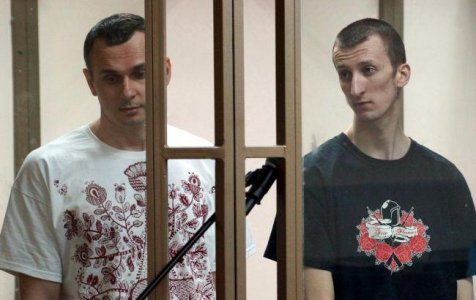
Oleg Sentsov and Alexander Kolchenko in the Russian court room
The repressions of the Russian authorities in Crimea touched, first of all, the Euromaidan activists and those, who didn’t hide own pro-Ukrainian position after the occupation. Most of the Revolution of Dignity participants were forced to leave the peninsula being apprehensive for their life. Nevertheless, many activists were held criminally responsible under various article of the Criminal Code, including on a charge of terrorism.
The director Oleg Sentsov, civic activists Gennady Afanasiev and Alexander Kolchenko, the historian Aleksey Chirniy were one of the first people suffered from the Russian persecution machine. They were arrested in Crimea in May 2014 and deported to Russia, where they were convicted on a charge of preparing terrorist acts on the peninsula.
The sentence for the Crimean supporters was severe: Afanasiev and Chirniy were sentenced to 7 years in prison, Kolchenko – to 10 years, and the “head” of the terrorist organization, according to the Russian court, Sentsov – to 20 years in prison.
Alexander Kostenko was convicted in Crimea for his participation in the Maidan events in Kiev in February 2014, in particular, for bodily injury to law enforcement officers. After the appeal, he was sentenced to 3 years and 11 months in standard regime penal colony. Today, another maidanovets Andrey Kolomiets, who is accused of attempting murder of the “Berkut” employees, is on trial.
One of the most notable cases was the case of “February 26”, the defendants of which were the Crimean Tatars – the participants of the pro-Ukrainian meeting near the building of the Supreme Council of Crimea on February 26, 2014. Two people have already received judgements of conviction on this “case”: Talyat Yusunov and Eskender Nebiev received suspended sentences – 3.5 and 2.5 years respectively. The trial against another six defendants, including the deputy chairman of the Majlis of the Crimean Tatar people Aktem Chiygoz, is still conducting. The initial charges of organizing and participating in mass disorders were expanded with suspicions of the extremis activity that invokes a more serious punishment.
The verdict for Ukrainian flag
In February 2016, the Crimean court delivered another verdict against the Crimean farmer Vladimir Balukh, whose house was decorated with the Ukrainian flag after the occupation, in the fabricated charges. The Russian law enforcement officers carried out a number of searches in the house of the farmer under artificial reasons, took the flag out and finally accused him of the “public insult of a public authority”. As a result, Balukh was sentenced to 320 hours of community service.
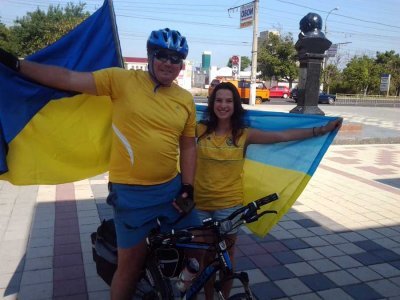
Sergey Dub near the Taras Shevchenko monument in Simferopol
Other pro-Ukrainian Crimeans are constantly exposed to various administrative penalties for the use of Ukrainain symbols. In particular, on August 24, 2014, in the Independence Day, Sergey Dub arrived by bicycle with the Ukrainian flag to the Taras Shevchenko monument in Simferopol. The police detained him, and the court found him guilty of disorderly conduct and sentenced to a fine of 500 rubles.
After the 201th anniversary of the birth of the Ukrainian poet Taras Shevchenko (on March 9, 2015), the Crimean law enforcement officers detained three protesters – Leonid Kuzmin, Veldar Shukurdzhiev and Alexander Kravchenko. They were sentenced to 40 hours of compulsory work for using the Ukrainian flag with the inscription “Crimea is Ukraine”. The Court of Appeal kept the sentence unreversed while replacing the community work with the fine of 10 thousand rubles. Another one participant of the meeting of March 9 Kurtseit Abdullaev was sentenced to 20 hours of compulsory work later.
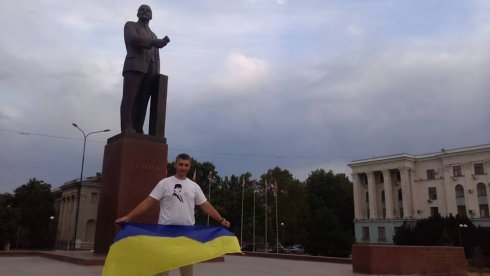
Veldar Shukurdzhiev with the Ukrainian flag on the central square of Simferopol
On August 11, 2015, Veldar Shukurdzhiev made a photo with the Ukrainian flag on the central square of Simferopo and was detained by police. In February 2016, the court sentenced him to a fine of 10,000 rubles.
On August 24, 2015, three Crimeans who were making a photo with the Ukrainian flag on the Mount Mithridat in Kerch. One of the detainees was sentenced to 15 days of detention; the second one was sentenced to a fine of 1,000 rubles.
On November 4, 2015, during the celebration of the Russian Unity Day, there were the flags of many nations living in Crimea on the central square of the Crimean capital. Just the Ukrainian flag was absent.
Education and culture: use the Ukrainian as little as possible
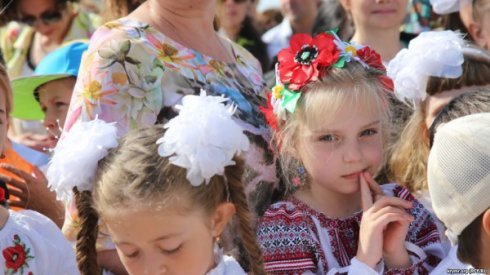
The Ukrainian gymnasium in Simferopol. Graduation. 2015
The Russian occupation authorities are conducting a policy of purposeful destruction of Ukrainian education. In particular, as of January 1, 2014, there were 7 Ukrainian schools and almost 500 classes with the Ukrainian language of instruction functioning in Crimea. One of the first steps of the new authorities was directed against the Ukrainian gymnasium in Simferopol, which was rightfully considered to be one of the best schools of the peninsula – it was turned into an ordinary school by abolishing the Ukrainian language of instruction. As of January 1, 2016, in Crimea, there is one school in Yalta, where the instruction is provided in the Ukrainian language.
If 12694 students used the Ukrainian as the language of instruction in Crimean schools in the 2014-2014 academic year, then already the next academic year there were just 1990 students – six times less.
The books published in Ukraine were removed from the schools and sent for recycling. Ukrainian school teachers were forced to leave the peninsula or take retraining courses. The faculty of Ukrainian philology was abolished in the central university of the peninsula – the Taurida National V.I. Vernadsky University, at the premises of which the Crimean Federal University was created.
Cultural institutions have also experienced serious transformation – in Simferopol, the occupation authorities transformed the Crimean Academic Ukrainian Music Theatre into the “State Academic Music Theatre of the Republic of Crimea” that was deprived of the Ukrainian repertoire. In 2014, they planned to deprive the Crimean Republican Scientific Library of the right to be named after the Ukrainian poet Ivan Franko. But they changed their mind for the time being. They also didn’t dare to rename the Simferopol cinema named after Taras Shevchenko into “Bayan”.
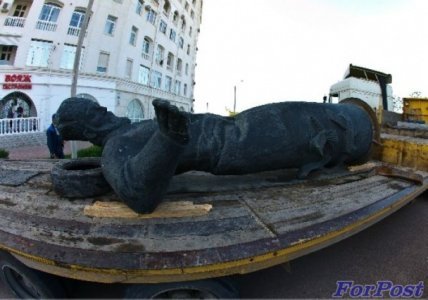
Dismantling of the Sagaidachny monument in Sevastopol, 2014
In Sevastopol, there were two monuments – the Ukrainian hetman Sagaidachny monument and the monument built in honor of the 10th anniversary of the Naval Forces of Ukraine – dismantled almost immediately after the annexation.
At the end of 2015, the Ukrainian-language children’s theater studio “Svitanok” was closed in Crimea. The theatrical performance for the St. Nicholas Day caused the closure. Officials were filled with indignation because of the fact that the Ukrainian scenes were not translated into Russian, and called young actors dressed in vyshyvankas along with the Ukrainian language the “entrenched nationalism”.
Oppression of Ukrainian churches
As the Ukrainian language and the Ukrainian culture are constantly pressured and hounded out of the peninsula, the Ukrainian Orthodox Church of the Kyivan Patriarchate (UOC-KP) was the only spiritual center of Ukraine. Undoubtedly, this fact is annoying for the occupation authorities. The pressure on the UOC-KP is carried out primarily by seizing the church premises and persecuting the priests.
In 2014, the UOC-KP was deprived of two temples – on the territory of the Training unit in Sevastopol and in the Perevalnoe village (Simferopol raion). Both premises were transferring to the ownership of the Orthodox Church of the Moscow Patriarchate.
As of January 1, 2014, the UOC-KP had 15 churches in Crimea, in 2016 it has just 10 of them. The destiny of the main church – Sts. Vladimir and Olga Cathedral located in the center of Simferopol – is still undetermined. In 2001, local authorities gave this premise for free use of the UOC-KP. However, after the annexation, conditions of using the premise were changed for the UOC-KP – the tailor-made rent assessment was introduced and this is beyond church’s funds. In addition, the occupation authorities deprived the church of 112.5 sq. m. of the facilities that were put up for sale and given to a new tenant. This makes it difficult for the church to work, as the entrance to the premises leased by a noon-profit organization passes through the church hall, where divine services are held.
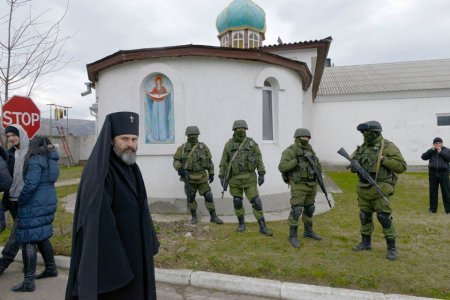
Archbishop Clement front of the goal Ukrainian military camp, March 2014
Appeals of the UOC-KP to the court were unsuccessful, so Ukrainian church members can be deprived of the church at any time. According to the Crimean UOC-KP archbishop Kliment, such actions of the “local authorities” create a threat for the existence of the church in Crimea.
The second leverage for the church was the re-registration of religious organizations in accordance with the Russian laws. The main danger for the UOC-KP is that after this re-registration, it can preserve own name, but will lose many benefits as a church with a center abroad (it is Kiev for the Kyivan Patriarchate).
The Ukrainian Greek Catholic Church (UGCC), many priests of which supported the Ukrainian military during the occupation of Crimea, found itself in a difficult situation as well. Later, they faced with threats and open prosecution. In April 2014, the head of the Yalta Greek Catholic community was forced to leave the annexed peninsula because of the “terrorism” charges from the FSB. In September 2014, unknown people kidnapped and detained the priest of the Evpatoria parish Kostetskiy for some time.
As a result, today the UGCC parishes are operating de facto in the semi-secret way, because Greek Catholics are considered the “radical nationalists” in Russia.
A serious problem for the Ukrainian priests was the citizenship, because they can stay on the territory of the occupied peninsula no more than 90 days without the Russian passport. For this reason, many priests left Crimea and they come just to hold a service on Sundays and religious holidays.
Thus, the occupation authorities systematically oust everything that could remind the people of the occupied Crimea of Ukraine from the peninsula. They create intolerable conditions of life for those, who don’t hide their pro-Ukrainian views. Nevertheless, according to the laws of physics: the greater power of influence, the stronger the resistance. In the meantime, the main form of protest for Crimeans are the pro-Ukrainian graffiti and inscriptions that regularly appear in different parts of the occupied peninsula.









